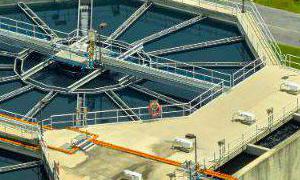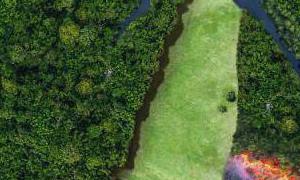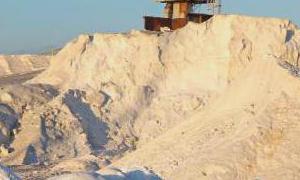Land use is a major factor in the composition and structure of vegetation, both native and non-native. In order to understand how land use is impacting vegetation, it is important to understand the different types of land use and how they affect plant life.
Land use can be divided into two main categories: natural land use and human-induced land use. Natural land use includes processes such as wildfire, flooding, and erosion, which can have a major effect on the composition and structure of vegetation. Human-induced land use includes activities such as agriculture, urbanization, forestry, and mining, which can also have a significant impact on vegetation.
Agriculture is one of the most common forms of land use and can involve the cultivation of plants, animals, or both. This type of land use can have a significant effect on the composition of vegetation in an area. For example, a single crop or animal species can dominate an area, which can cause the loss of other species or lead to a decrease in biodiversity.
Urbanization is another form of land use that can have a major impact on vegetation conditions. As cities expand, they often involve the removal of native vegetation in order to make room for housing and other services. This can lead to the displacement of native species and an increase in non-native species. Additionally, urbanized areas often have higher concentrations of pollutants, which can further impact native vegetation.
Forestry is another type of land use that can affect vegetation conditions. This type of land use involves the harvesting of trees for timber or other products, which can have a major impact on the composition and structure of vegetation in an area. For example, clearcutting large areas of forest can cause the loss of certain species that are unable to survive in the newly created environment.
Finally, mining is another form of land use that can have a major impact on vegetation conditions. Mining activities often involve the excavation of minerals and rocks, which can cause soil erosion and compaction, leading to a decrease in vegetation cover. Additionally, mining operations often release pollutants into the environment, which can further degrade vegetation conditions.
In conclusion, land use is an important factor in determining the composition and structure of vegetation in an area. Different types of land use can have varying impacts on vegetation, including the displacement of native species, a decrease in biodiversity, soil erosion and compaction, and the release of pollutants into the environment. Therefore, it is important to consider how land use is impacting vegetation conditions when making decisions about land management and conservation.
Adapting Agriculture to Meet the Challenges of Vegetation Conditions
Agriculture is a major component of land use, and its practices can have a massive impact on the health of vegetation in an area. With the climate changing, the challenges faced by farmers and growers are becoming increasingly difficult. In order to ensure that our food supply is secure and that vegetation is not impacted by agricultural activities, it is necessary to understand how to adapt agricultural practices to meet the changing needs of the environment.
One approach is to focus on conservation agriculture, which is an integrated approach to farming that emphasizes soil health, water conservation, and pest management. Conservation agriculture involves techniques such as no-till farming, crop rotation, cover cropping, and integrated pest management. By using these techniques, farmers can reduce their impact on the environment while still maximizing their yields. For example, no-till farming helps to prevent soil erosion, while crop rotation helps to control pests and reduce the need for chemical inputs.
Another way to adapt to changes in vegetation conditions is to practice precision agriculture. This approach utilizes advanced technologies such as GPS and remote sensing to help farmers make more informed decisions about their land use and farming practices. Precision agriculture allows farmers to monitor soil properties, climate conditions, and other factors in order to optimize their production. For example, by using satellite imagery, farmers can determine which parts of their land are most suitable for growing certain crops and adjust their planting methods accordingly.
Finally, it is important for farmers to consider the use of alternative crops. Many traditional crops are becoming increasingly difficult to grow due to changing environmental conditions, so it is important for farmers to explore alternative crops that may be better suited to the unique conditions of their land. This can help increase crop yields while also reducing the negative impact of traditional farming methods on the environment.
By understanding the role of land use in shaping vegetation conditions and adapting agricultural practices accordingly, farmers can help ensure that our food supply is secure while also preserving our natural ecosystems.
Preserving Biodiversity in an Era of Changing Vegetation Conditions
In an age of changing climates and rapidly shifting landscapes, preserving biodiversity is becoming increasingly important. As vegetation conditions change, it is essential to understand the role of land use in shaping the environment and its associated biodiversity.
Preserving biodiversity requires us to consider the consequences of land use decisions. Land use can have a significant impact on the health and stability of ecosystems, as well as the organisms that rely on them for survival. For example, land conversion from forest or grassland to agricultural production can reduce habitat diversity and eliminate critical habitat for species. In addition, land use can affect water resources, soil fertility, and air quality, creating further challenges for biodiversity conservation.
Fortunately, there are steps we can take to reduce the impacts of land use on biodiversity. For instance, conservation efforts such as habitat restoration, reforestation, and agroforestry can help maintain viable populations of threatened species. In addition, sustainable agricultural practices—such as the use of cover crops, crop rotation, and integrated pest management—can help protect soil quality and reduce the risk of soil erosion. Furthermore, effective land-use planning can help ensure that natural resources are managed in an ecologically sound manner.
As vegetation conditions continue to change due to human activities, it is essential that we take steps to preserve biodiversity. By understanding the role of land use in shaping vegetation conditions and taking action to mitigate our impacts, we can help ensure that future generations will have access to a healthy and diverse environment.
What Causes Changes in Vegetation Conditions?
Vegetation conditions can be affected by a variety of factors, including land use. Land use directly impacts the types of plants that grow in an area, as well as the abundance and health of those plants. For example, areas that are heavily developed for urban and commercial use may not have enough space or resources to support the same amount of vegetation as undisturbed areas. Additionally, land use practices such as agriculture, logging, and mining can alter the soil composition and water resources available to plants, leading to changes in vegetation conditions. In addition to land use, changes in climate, soil type, and other factors can also contribute to changes in vegetation conditions.
Climate change is one of the most significant drivers of changes in vegetation conditions. Increasing temperatures, changing precipitation patterns, and increasing levels of atmospheric CO2 can all alter the growth and health of vegetation in an area. For example, higher temperatures can cause plants to mature faster and decrease their ability to withstand drought or other environmental stresses. Additionally, rising temperatures can lead to changes in the types of plants that are able to survive in a certain area, and higher levels of CO2 can enable some species to outcompete others.
Soil type is also an important factor in determining vegetation conditions. Different types of soils have different levels of nutrients and water availability, which can affect the types of plants that can thrive in an area. For example, sandy soils tend to have lower nutrient levels than clay-based soils, limiting the types of plants that can survive in those areas. Additionally, soil texture and composition can affect the amount of water available to plants, which in turn impacts their growth and health.
Human activities can also lead to changes in vegetation conditions. For instance, pollution from industrial activities can contaminate soil and water resources, making it difficult for some plants to survive. Overgrazing of an area can cause soil erosion and reduce the amount of vegetation that is able to grow there. Additionally, urbanization can reduce the amount of green spaces available for plant growth, leading to changes in the type and abundance of vegetation in an area.
In summary, land use is just one of many factors that can cause changes in vegetation conditions. Climate change, soil type, and human activities can all contribute to changes in the types of plants that are able to survive in an area, as well as the health and abundance of those plants. It’s important to consider all these factors when assessing the impact of land use on vegetation conditions.




